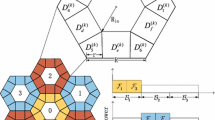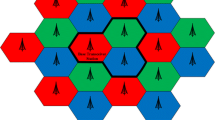Abstract
Network-based dynamic channel assignment (DCA) schemes can be used to increase the capacity of TDMA cellular systems. In this paper, a new distributed network-based DCA scheme, known as DCA with interference information, DCA-WI, is proposed and its performance is studied. In this scheme, a base station (BS) assigns a channel in such a way as to minimize the effect on the availability of channels for use in its interfering cells. To accomplish this, each BS maintains an interference information table which contains information about the local cell and its interfering cells. DCA-WI does not require system-wide information. Channel reassignment for new and completed calls are used to further reduce the call blocking probability. Simulation results show that DCA-WI provides a lower call blocking probability compared to other existing schemes in both uniform and nonuniform traffic distributions.
Similar content being viewed by others
REFERENCES
W. C. Y. Lee, Mobile Cellular Communication Systems, 2nd ed. New York: McGraw-Hill, 1995.
N. Sollenberger, N. Seshadri, and R. Cox, The evolution of IS-136 TDMA for Third-Generation Wireless Services, IEEE Pers. Commun., Vol. 6, No. 3, pp. 8–18, June 1999.
J. Engel and M. Peritsky, Statistically-Optimum dynamic server assignment in systems with interfering servers, IEEE Trans. Veh. Technol., Vol. VT-22, no. 4, pp. 203–209, Aug. 1973.
M. Sengoku, M. Kurata, and Y. Kajitani, Rearrangements in a small cell mobile radio systems, in Proc. of IEEE ICC'81, pp. 23.7.1–23.7.5, June 1981.
S. Nanda and D. Goodman, Dynamic resource acquisition: Distributed carrier allocation for TDMA cellular systems, in Proc. of IEEE GLOBECOM'91, pp. 883–889, 1991.
E. Del Re, R. Fantacci, and G. Giambene, Handover and dynamic channel allocation techniques in mobile cellular networks, IEEE Trans. on Veh. Technol., Vol. 44, No. 2, pp. 229–237, May 1995.
S. Elnoubi, R. Singh, and S. Gupta, A new frequency channel assignment in high capacity mobile communication systems, IEEE Trans. Veh. Technol., Vol. VT-31, No. 3, pp. 125–131, Aug. 1982.
S. Kuek and W. Wong, Ordered dynamic channel assignment scheme with reassignment in highway microcells, IEEE Trans. Vech. Technol., Vol. 41, No. 3, pp. 271–277, Aug. 1992.
M. Zhang and T. Yum, Comparisons of channel assignment strategies in cellular mobile telephone systems, IEEE Trans. Veh. Technol., Vol. 38, No. 4, pp. 211–215, Nov. 1989.
K. Chang, J. Kim, C. Yim, and S. Kim, An efficient borrowing channel assignment scheme for cellular mobile systems, IEEE Trans. Veh. Technol., Vol. 47, No. 2, pp. 602–608, May 1998.
K. Yeung and T. Yum, Compact pattern based dynamic channel assignment for cellular mobile systems, IEEE Trans. Veh. Technol., Vol. 43, No. 4, pp.892–896, Nov. 1994.
C. I. and P. Chao, Local packing-Distributed dynamic channel allocation at cellular base station, in Proc. of IEEE GLOBECOM' 93, pp. 293–301, 1993.
Author information
Authors and Affiliations
Rights and permissions
About this article
Cite this article
Chong, P.H.J., Leung, C. A Network-Based Dynamic Channel Assignment Scheme for TDMA Cellular Systems. International Journal of Wireless Information Networks 8, 155–165 (2001). https://doi.org/10.1023/A:1012378931278
Issue Date:
DOI: https://doi.org/10.1023/A:1012378931278




